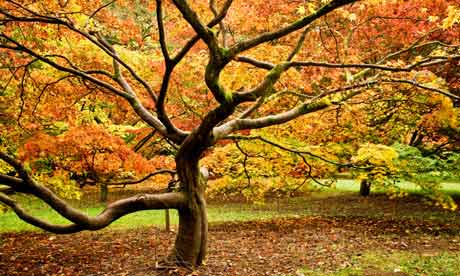Nice little guide from the Guardian to Britain’s common garden birdsongs. Find out which birds sound like a bicycle pump or a squeaky trolley wheel and which can imitate car alarms.
Category Archives: Gardens of Britain
Mammals in British gardens

92,000 people have taken part in the RSPB’s survey of garden wildlife, Make Your Nature Count, taking in 69,000 gardens in the UK. In addition to birds, the RSB asked participamts to look out for certain species of mammals. Above image: Nigel Blake (rspb-images.com)
Fourteen per cent recorded the presence of moles, with half of these detecting moles regularly. Unsurprisingly, most moles were detected in rural gardens, being most frequently seen (or at least their molehills) in Wales in 25% of gardens, compared with 15% in Scotland and 13% in England. There are no moles in Northern Ireland. Roe deer were recorded in 5% of gardens, with most sightings came from Scotland, where they were seen in 16% of gardens, compared to 4% in England and only 0.5% in Wales. There are no roe deer in Northern Ireland.
Hedgehogs were seen in 30% of gardens in urban areas, and more than one in seven saw them regularly. Hedgehog expert Hugh Warwick said: “Gardens are clearly very important for hedgehogs, a great example of a truly wild animal not only at home with us but also of great benefit to gardeners. “We should treasure the fact that they live comfortably in our gardens and so many people can get nose-to-nose with them.” The Guardian
A lucky 5%, in my opinion, saw badgers, including more than 20& in Somerset and Pembrokeshire.
The results:
| Badger | 5.50 |
| Fox | 26.23 |
| Muntjac deer | 1.91 |
| Hedgehog | 23.35 |
| Roe deer | 2.22 |
| Mole | 7.33 |
| Red Squirrel | 0.77 |
| Cat | 79.41 |
Results of 2010 RSPB Garden Birdwatch

As expected, small birds struggled to survive the big freeze: long tailed tits, who had prospered over a succession of mild winters, dropped by 27% compared to last year, when they made the top ten for the first time. The biggest decline was in goldcrest sightings – down by 75%. Losses would have been worse without the tremendous response to calls for keeping bird tables well stocked.
Another effect of the hard winter was a movement of countryside birds into gardens in their search for food. Sightings of redwings increased by 185%, fieldfares by 73% and song thrushes by 51%. Yellowhammers and bullfinches were also more frequent garden visitors. Continue reading Results of 2010 RSPB Garden Birdwatch
Snowdrops, the poet’s flower

Poets love snowdrops. Even Linnaeus got lyrical when he classified them as Galanthus nivalis, which translates as “milky flower of the snow” (in Greek, gala = milk and anthos = flower). For St. Francis the snowdrop was an emblem of hope and the touch of green on the inner petals has often been seized upon as a symbol of spring’s return. It is uplifting to see the green sword-shaped leaves piercing the snow and the apparently fragile bell-shaped flowers resisting all that winter can hurl at them.
There is some disagreement about when the snowdrop was introduced to Britain: some say as late as the 16th century. It’s noticeable for its absence in Shakespeare. Snowdrops grow particularly profusely in damp deciduous woodlands, and flower from January to March: this year the Big Freeze has delayed them.
A list of gardens with particularly good snowdrop displays can be found here.
Autumn gardens

The Guardian has compiled a list of garden-related autumn activities, ranging from visiting ornamental woodlands such as the Westonbirt Arboretum in Gloucestershire for a blast of autumn colours to organic apple juice-tasting in south London.
The house and garden of Roger Deakin

Anyone who has enjoyed reading Roger Deakin’s books, especially Waterlog and Notes from Walnut Tree Farm, will love listening to these radio programmes that he recorded for the BBC. Produced by Sara Blunt, the 25 minute-long programmes capture Deakin’s unusual home and garden, and the man who lived there. The producer deliberately chose not to use an interviewer, instead allowing Deakin to draw you into his world with his own words. Continue reading The house and garden of Roger Deakin
Gardens on London’s barges

One of the most unusual corners of London is the remarkable Garden Barge Square (Photo: Drew Bennellick) where a community of barge owners live right by next to Tower Bridge. These historic moorings date back 200 years or more. Gardens have been created on the decks of many of the barges to form a kind of floating garden square. But be warned barge living is not as romantic it first might seem. The Thames is cold, damp and grey in winter and the cabins are cramped. See more on Tree Hugger.
See also: Anatomy of a garden: Barge gardens (The Guardian) “Floating on the Thames just downstream from Tower Bridge are the most extraordinary gardens, yet thanks to their illustrious neighbour they’re largely unnoticed.”
Green roofs

When a million-strong swarm of ladybirds landed on Blackdown Horticultural farm recently, every time the staff ventured outside they were coated in insects. But the red cloud brought good publicity for their enterprise: green roof installation.
The swarm had arrived to feast on aphids living on pesticide-free sedum plants, a staple of green roofs since these succulents are drought-resistant and thrive in well-drained conditions. Continue reading Green roofs
The Ha-Ha

A ha-ha is a sunken wall, invisible until you’re nearly on top of it. They became popular in the 18th century when attitudes to nature in Britain were changing. Continue reading The Ha-Ha